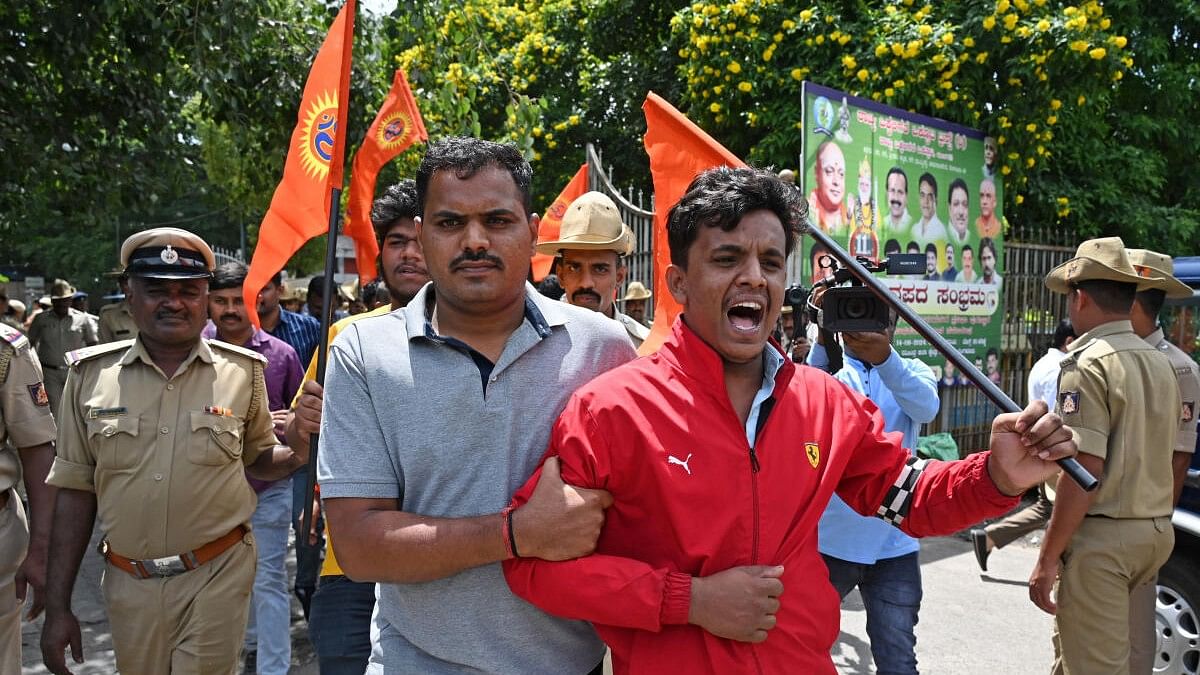
Police detain members of Bengaluru Mahanagara Ganesha Utsava Samithi at Town Hall, Benlgauru on Friday as they gather to protest against an untoward incident during Ganesha immersion procession in Mandya’s Nagamangala.
Credit: DH Photo/Pushkar V
When the Nagamangala riots happened, a deep sense of unease hit. What had happened? What happens every time one of these ‘communal clashes’ happens? What hides behind the news headlines? Questions with no answers. Until something happens close home and the mystery boils down to… But I get ahead of myself.
Cut to a few days after the riot. The time of Ganesh Chaturthi processions as organisers fanned across Bengaluru seeking a token body of water to bid the Tusked God goodbye.
The area of Bengaluru where I live has a mixed population. Christians, Hindus, and Muslims. My landlord happens to be Muslim. He has rented out the top-most two flats in his building to a Hindu family, us, and a Sikh family. The rest of the eight flats have Muslim residents. The building has a Nepali security guard who lives on the ground floor with his family.
The microcosm
Why is this important? Because this is the microcosm of it all. A typical building on a typical street on a typical day in Bengaluru with a mixed population of residents.
The only atypical thing about the day was the Ganesh procession that would wind through the lane in front of the building.
The police, it can be assumed, had two or three bits of information. One, the roof of our building made an excellent spot to pelt stones from. Two, the building’s landlord was Muslim as were most of the residents.
Thus, it wasn’t unusual for the police to turn up in the afternoon, demanding to inspect the roof and asking to be allowed to station a constable or two on the roof as the procession passed.
My landlord, with a healthy sense of fear and suspicion of the police, was also understandably unenthused about allowing such access. What if they ‘framed’ him?
So he told our Nepali guard to deal with it and prevent access when he and his sons weren’t around to see what they’d be doing. The guard, reluctantly as the messenger with a thankless job, told the police that he couldn’t give access to the roof without the landlord’s express permission.
To make matters worse, the lady of the house on the first floor (in a fit of rebellion with very poor timing), yelled from her balcony ‘not to be afraid’ to the guard while the police were still meandering around.
The police, incensed, threatened to put my landlord and the guard in jail. The guard. feeling cornered but defiant, said, “Sure. Whatever you want. Arrest my baby and wife too.”
A fight was imminent. You could sense the residents getting restless — one teen (with a few rumoured run-ins with the law) looking tense and agitated.
Thankfully, better sense prevailed and one of the landlord’s sons arrived at some point to allow the police in to prove ‘Look Ma, no stones.”
There were no stones. The two policemen who sat on the roof all night had a blessedly boring night and the procession passed peacefully under a typical building on a typical day in Bengaluru.
And yet, for a little while in the afternoon, violence was imminent, made manifest by two nodes of suspicion and fear, mixed with a little rebellion, a little defiance of speech of a scapegoat refusing to be made one any more.
The third node, when and if it develops, spawns the poisonous blooms of hate. When the red descends and logic is swept clean from minds.
There is a very long tradition of the ‘scapegoat’, the first written accounts coming in from Ancient Greece and ancient Syria of a person—usually from a lower class, a slave or a prisoner—who would be dressed up and fed meals before being stoned and driven out of the community or stoned to death so that the plague or the drought or the floods would pass by without inflicting much damage.
Anthropologists can trace the practice back to even older hunter-gatherer communities where an animal sacrifice recreated ‘the hunt’ and the sacrifice became a way to release the fear, the guilt, the sin of the hunt that sustained the community onto the animal being sacrificed.
The scapegoat concept is a symbolic idea that depends entirely on the sacrifice of the individual for the sake of the group. The concept persists in Abrahamic religions and communities - Jewish, Christian, Islamic, pagan traditions, and even the Hindu idea of ‘bali’
Ursula Le Guin’s The Ones Who Walk Away from Omelas, a short fictional work that explores the idea as a philosophical question, imagines a city of perfect happiness. However, for this ‘universal happiness’ of the collective, Le Guin posits that one child must suffer extreme neglect and torture so the other citizens may experience joy. The condition of life among the Omelas is that for society to be happy, the child must suffer without reprieve. A twisted proposition.
The Macrocosm…
But it is a proposition whose reflection we find in our every day, here and now. A projection of sins onto the other, religious or otherwise, a convenient scapegoating, often with no questions asked to establish guilt, a sacrifice delivered, a sin assuaged. And if an ideal scapegoat isn’t available, one of our own will do.